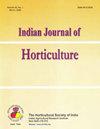甜橙cv的间接体细胞胚胎发生。“Mosambi”
Q4 Agricultural and Biological Sciences
引用次数: 0
摘要
在2019-2022年期间,采用不同外植体(上胚轴、子叶和根)、植物生物调节剂(PBRs)和碳源对间接胚胎发生进行研究,以标准化可靠的方案。结果表明,T4 (MS + 2,4- d (1.5 mg L-1) + BAP (1.0 mg L-1) + ME (500 mg L-1)处理对愈伤组织的愈伤组织质量(90.89%)、愈伤组织鲜重(0.83 g)、肿重(0.84 g)和干重(0.08 g)的促进作用最好。外植体上胚轴(E)愈伤组织愈伤率(83.72%)、愈伤组织鲜重(0.67 g)、膨体重(0.68 g)、干重(0.05g)和愈伤组织含水量(11.28%)均优于其他外植体。同样,T4 × E处理组合在愈伤潜能方面优于其他处理组合。T7 (MS + BAP (2 mg L-1) + NAA (0.1 mg L-1) + ME (500 mg L-1))的胚胎发生率为59.09%,发芽率为33.61%。在不同碳源中,5%甘油添加T7诱导的体胚/愈伤组织质量最高(73.26),胚发生率最高(65.27%),成苗率最高(68.77%)。标准化方案可用于不同基因型甜橙的间接胚胎发生。本文章由计算机程序翻译,如有差异,请以英文原文为准。
Indirect somatic embryogenesis in sweet orange cv. “Mosambi”
This study was carried out for standardization of a reliable protocol by using different explants (epicotyl,cotyledon, and root), plant bioregulators (PBRs), and carbon sources on indirect embryogenesis during 2019-2022. Among the treatments tested, T4 (MS + 2,4-D (1.5 mg L-1) + BAP (1.0 mg L-1) + ME (500 mg L-1)) proved bestfor callusing (90.89 %), callus fresh weight (0.83 g), turgid weight (0.84 g) and dry weight (0.08 g) as comparedto others. In terms of callusing (83.72%), callus fresh weight (0.67 g), turgid weight (0.68 g), dry weight (0.05g) and callus water content (11.28 %), explants epicotyl (E) showed its superiority over others. Similarly, thetreatment combination T4 × E surpassed others in callusing potential. Embryogenesis (59.09%) and germination(33.61%) were best in T7 (MS + BAP (2 mg L-1) + NAA (0.1 mg L-1) + ME (500 mg L-1)). Among the different carbonsources, 5% glycerol supplemented with T7 proved best in inducing the highest number of somatic embryos/callus mass (73.26), embryogenesis (65.27%), and plantlet formation (68.77%). The standardized protocol canbe used for indirect embryogenesis for different genotypes of sweet orange.
求助全文
通过发布文献求助,成功后即可免费获取论文全文。
去求助
来源期刊

Indian Journal of Horticulture
农林科学-园艺
CiteScore
0.50
自引率
0.00%
发文量
22
审稿时长
4-8 weeks
期刊介绍:
Information not localized
 求助内容:
求助内容: 应助结果提醒方式:
应助结果提醒方式:


